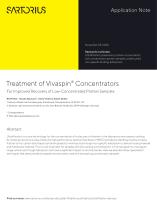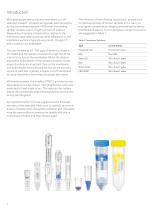
Catalog excerpts

Application Note November 05, 2020 Keywords or phrases: Ultrafiltration, passivation, protein concentration, low-concentration protein samples, protein yield, non-specific binding, adsorption Treatment of Vivaspin® Concentrators For Improved Recovery of Low-Concentrated Protein Samples Rik McRae¹,*, Claudia Naumann²,*, Kristin Hoehne, Robert Zeidler 1. Sartorius Stedim Lab Ltd, Sperryway, Stonehouse, Gloucestershire, GL10 3UT, UK 2. Sartorius Lab Instruments GmbH & Co. KG, Otto-Brenner-Straße 20, 37079 Göttingen, Germany * Correspondence E-Mail: adam.green@sartorius.com Abstract Ultrafiltration is a core technology for the concentration of molecules of interest in the laboratory and research setting. As molecule recovery is a key criteria for high performance; optimal membrane, MWCO and device handling must be in place. Further to this, certain techniques can be employed to minimize loss through non-specific adsorption to device housing material and membrane material. This is most important for samples with low starting concentrations in the nanogram to microgram range, where loss through adsorption can have a significant impact on end recoveries. Here we describe these “passivation” techniques that demonstrate increased recovery when used with low starting concentration samples. Find out more: www.sartorius.com/en/products/lab-filtration-purification/ultrafiltration-d
Open the catalog to page 1
Introduction With appropriate device size and membrane cut-off selected, Vivaspin® products will typically yield recoveries for the concentrated sample > 90% when the starting sample contains over 0.1 mg/mL protein of interest. Depending on sample characteristics relative to the membrane type used, solute (protein) adsorption on the membrane surface is typically very low (2 – 10 µg/cm²) and in practice not detectable. This can increase to 20 – 100 µg/cm² when the filtrate is of interest and the sample must pass through the whole internal structure of the membrane. Whilst the relative...
Open the catalog to page 2
Results and Discussion Passivation Procedure for Vivaspin® Ultrafiltration Concentrators A) Passivation Procedure 1. Wash the concentrators once by filling with Arium® water and spin the liquid through according to the respective protocol. 2. Remove residual water thoroughly by pipetting. Caution: Take care not to damage the membrane with the pipette tip. 3. Fill concentrators with the blocking solution of choice as given in Table 1. 4. Incubate the filled concentrators at room temperature for at least 2 hours (overnight is also possible except for Triton X-100 which is not recommended for...
Open the catalog to page 3
Summary Passivation is an appropriate method to achieve increasing sample recovery when using very dilute samples. In addition to skimmed milk, other proteins (BSA), detergents and compounds are possible. However, it should be noted that this is a general procedure, not specific for any particular application. Depending on the hydrophilic | -phobic character of the protein non-specific binding may be more or less of a problem and the suggested passivation solutions may lead to different results. Even with the Hydrosart membrane, which is recommended for dilute samples, passivation of the...
Open the catalog to page 4All Sartorius Group catalogs and technical brochures
-
OEM
52 Pages
-
Octet® R2 System
7 Pages
-
Unisart® CN 180 DX Membrane
4 Pages
-
Pipette Cleaning
1 Pages
-
continuous air monitoring
6 Pages
-
Pipette Essentials
2 Pages
-
Contamination in Pipetting
4 Pages
-
ABC of pipette tips
1 Pages
-
Vivaflow®
12 Pages
-
Vacusart
2 Pages
-
Sterisart® Sterility Testing
6 Pages
-
Sterisart® NF
4 Pages
-
Sterisart® Family
12 Pages
-
Speedcal Mobile
2 Pages
-
Sartocheck® 5 Plus Filter Tester
26 Pages
-
Rline® Dispenser Module
4 Pages
-
Quintix® and Secura®
24 Pages
-
Picus® and Picus® NxT
8 Pages
-
Midi Plus Pipette Controller
4 Pages
-
Microbiological QC Solutions
12 Pages
-
MA160 Moisture Analyze
8 Pages
-
Filter Papers
36 Pages
-
Cubis® II
12 Pages
-
Claristep® Filtration System
12 Pages
-
Arium® Mini
11 Pages
-
Ultrafiltration Family
96 Pages























































